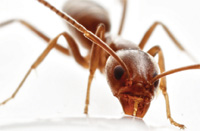Once the thermometer begins to climb to the high 80s and 90s in our Greater Sacramento pest control region, ant season will have arrived. Ants are not only one of the most common nuisances to homeowners, who may find them trailing across the kitchen floor to feed, and ruin, every open package in the pantry, they also invade grocery stores, restaurants, offices and warehouses—anywhere they can get access to their favorite foods and water.

Worldwide there are more than 12,400 different ant species, according to the University of California Davis Integrated Pest Management Program, and 240 different species in California alone. The most common nuisance ant in our Northern California region is the Argentine ant, a tiny (1/8th inch long) insect with an uneven thorax that ranges in color from dark to light brown. In cool weather Argentine ants may nest outdoors in the open, in shallow, 1- to 2-inch deep mounds of disturbed soil, moving to shaded locations as the summer grows hot.
Argentine ants prefer a mild, Mediterranean climate, which is why they have thrived in California. They originated in Southern America and are believed to have been introduced in the United States by coffee ships transporting coffee beans from Brazil to the port of New Orleans. In their native territory, they compete with other ant species and maintain colony borders with other Argentine ant colonies, which prevents them from dominating their environment. But in non-native areas where they are introduced, such as the U.S., they overwhelm and displace other ant species and, instead of forming separate colonies, create vast “super-colonies.”
For the home- or business owner, Argentine ants can be an aggressive, costly nuisance, and one of the most difficult ant species to eliminate. That’s because of its unusual biology and its ability to form super-colonies. Most ant species have a single queen per colony, and worker ants scout from and return to their respective colonies. But, as reported by PCT Magazine, Argentine ants have multiple queens, and the worker ants can return to any colony. Colonies are often connected via tunnels, with no centralized nest that can be destroyed, and a single uni-colony can span hundreds of miles.
Hot, dry weather takes a natural toll on the population of aphids and other insects that generate honeydew, the Argentine ant’s preferred food. As its food source dies off in the summer heat, the Argentine ant goes looking for other sources of sugary, oily nutrition, and your home, store or restaurant may become an attractive destination. Wiping the ant trails with Windex or sprinkling borax detergent on countertops may relieve a small infestation, particularly if you catch it early. Larger infestations require finding and sealing the ants’ entryways, often along pipes or electrical conduit, and placement of baits to reduce the population.
Small and unobtrusive as it appears, the tiny ant is mighty in numbers, and in the aggravation and potential loss of business it can cause.


